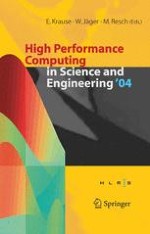2005 | OriginalPaper | Chapter
Numerical Considerations of Fluid Effects on Wave Propagation
Authors : Erik H. Saenger, Oliver S. Krüger, Serge A. Shapiro
Published in: High Performance Computing in Science and Engineering’ 04
Publisher: Springer Berlin Heidelberg
Activate our intelligent search to find suitable subject content or patents.
Select sections of text to find matching patents with Artificial Intelligence. powered by
Select sections of text to find additional relevant content using AI-assisted search. powered by
This paper is concerned with numerical considerations of fluid effects on wave propagation. The focus is on effective elastic properties (i.e. velocities) in different kinds of dry and fluid-saturated fractured media. We apply the so-called rotated staggered finite-difference grid (RSG) technique. Using this modified grid it is possible to simulate the propagation of elastic waves in a 2D or 3D medium containing cracks, pores or free surfaces without explicit boundary conditions and without averaging elastic moduli. Therefore the RSG allows an efficient and precise numerical study of effective velocities in fractured structures. This is also true for structures where theoretically it is only possible to predict upper and lower bounds. We simulate the propagation of plane P- and S-waves through three kinds of randomly cracked 3D media. Each model realization differs in the porosity of the medium and is performed for dry and fluid-saturated pores. The synthetic results are compared with the predictions of the well known Gassmann equation and the Biot velocity relations. Although we have a very low porosity in our models, the numerical calculations showed that the Gassmann equation cannot be applied for isolated pores (thin penny-shaped cracks). For Fontainebleau sandstone we observe with our dynamic finite-difference approach the exact same elastic properties as with a static finite-element approach. For this case the Gassmann equation can be checked successfully. Additionally, we show that so-called open-cell Gaussian random field models are an useful tool to study wave propagation in fluid-saturated fractured media. For all synthetic models considered in this study the high-frequency limit of the Biot velocity relations is very close to the predictions of the Gassmann equation. However, using synthetic rock models saturated with artificial “heavy” water we can roughly estimate the corresponding tortuosity parameter.
